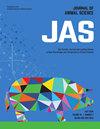Evaluation of dietary acid-binding capacity level on nursery pig growth performance and fecal dry matter
IF 2.7
2区 农林科学
Q1 AGRICULTURE, DAIRY & ANIMAL SCIENCE
引用次数: 0
Abstract
Two experiments were conducted to evaluate dietary acid-binding capacity-4 (ABC-4) level on weanling pig performance and fecal dry matter (DM). In both experiments, there were 5 pigs per pen and 12 replications per dietary treatment fed in two phases. In Exp. 1, 360 barrows, initially 5.9 kg, were allotted to 1 of 6 treatments. Five treatments were formulated with increasing ABC-4 ranging from 150 (low ABC-4) to 312 meq/kg (high ABC-4) in phase 1 and 200 (low ABC-4) to 343 meq/kg (high ABC-4) in phase 2. The low ABC-4 diet was formulated with specialty soy protein concentrate (SSPC; AX3 Digest, Protekta, Newport Beach, CA) and a combination of dietary acidifiers. Increasing ABC-4 was achieved by progressively replacing SSPC with enzymatically treated soybean meal (ESBM; HP 300, Hamlet Protein, Findlay, OH) on a standardized ileal digestible (SID) Lys basis and decreasing acidifiers. Diets were formulated to contain 100 mg/kg of Zn. For the sixth treatment, pharmacological levels of Zn from ZnO was added to the high ABC-4 diet. From d 0 to 23 and d 0 to 38, increasing ABC-4 increased then decreased (quadratic, P ≤ 0.046) ADG and ADFI. On d 10 and 17, increasing ABC-4 decreased (linear, P ≤ 0.022) fecal DM. From d 0 to 23, pigs fed the diet containing ZnO had increased (P ≤ 0.009) BW, ADG and ADFI compared to the high ABC-4 diet without ZnO. In Exp 2, 300 pigs, initially 6.0 kg, were allotted to 1 of 5 dietary treatments. Diet 1 was a low ABC-4 diet formulated to 200 and 250 meq/kg in phase 1 and 2, respectively. Two intermediate ABC-4 levels were formulated by either replacing SSPC with ESBM on an SID Lys basis (diet 2) or removing acidifiers (diet 3). Diet 4 was a high ABC-4 diet formulated by replacing SSPC and removing acidifiers to increase ABC-4. Diet 5 was diet 4 but with pharmacological levels of Zn from ZnO. Diets 1 through 4 contained 110 mg/kg of Zn. From d 0 to 24 and d 0 to 38, increasing ABC-4 decreased (linear, P ≤ 0.046) G:F. On d 10 and 24, increasing ABC-4 decreased (linear, P ≤ 0.005) fecal DM. From d 0 to 24, pigs fed the diet containing ZnO had increased (P ≤ 0.047) BW, ADG, ADFI, and G:F compared to the high ABC-4 diet without ZnO. In conclusion, an ABC-4 of 200 meq/kg from d 0 to 10 post-weaning and 250 meq/kg from d 10 to 24 post-weaning improves pig growth performance and fecal DM for compared to higher ABC-4 diets. In diets without ZnO, low ABC-4 diet formulation can improve performance and fecal DM of weanling pigs.求助全文
约1分钟内获得全文
求助全文
来源期刊

Journal of animal science
农林科学-奶制品与动物科学
CiteScore
4.80
自引率
12.10%
发文量
1589
审稿时长
3 months
期刊介绍:
The Journal of Animal Science (JAS) is the premier journal for animal science and serves as the leading source of new knowledge and perspective in this area. JAS publishes more than 500 fully reviewed research articles, invited reviews, technical notes, and letters to the editor each year.
Articles published in JAS encompass a broad range of research topics in animal production and fundamental aspects of genetics, nutrition, physiology, and preparation and utilization of animal products. Articles typically report research with beef cattle, companion animals, goats, horses, pigs, and sheep; however, studies involving other farm animals, aquatic and wildlife species, and laboratory animal species that address fundamental questions related to livestock and companion animal biology will be considered for publication.
 求助内容:
求助内容: 应助结果提醒方式:
应助结果提醒方式:


